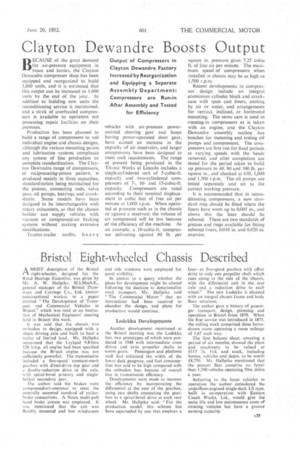Bristol Eight-wheeled Chassis Described
Page 53

If you've noticed an error in this article please click here to report it so we can fix it.
ABRIEF description of the Bristol eight-wheeler, • designed, for the Road Flaulage.Executive, was given by Mr. A. W. Hallpike,
general manager 'of. the Bristol Tramways and Carriage Co., Ltd. (motor constructional Works),. in a:paper entitled ". The Development of Transport and Commercial Vehicles in Bristol." which was read at an Institution of Mechanical Engineers' meeting held in Bristol this week."
It was said that the chassis was orthodox in design, equipped with a single driving axle and bilk to haul a trailer of limited load. Mr. Hallpike mentioned that the Leyland 9.8-litre 120 b.h.p. oil engine had been specifiedheca use the Bristol. engine was not sufficiently powerful. The transmission included a five-speed constant-mesh gearbox with direct-drive top gear and a double-reduction drive .to the axle, with spiral-bevel primary and singlehelical secondary gear.
The author said the brakes were compressed-air-operated to meet the generally accepted 'standard of trailerbrake connections. A Neate multi-pull hand brake system was employed. It was mentioned that the cab was flexibly mounted and low windscreen and side windows were employed for good visibility.. In answer to a query whether the plans for development might be altered following the decision to denationalize road transport, Mr. Hallpike told "The Commercial Motor" that no instructions had been received to abandon the design, arid plans for production would continue.
Lodekka Developments
Another development Mentioned at the Bristol meeting was the Lodekka bus, two prototypes of which were produced. in 1948 with intermediate cross drives and twin propeller shafts to worm gears. Passengers and platform staff had criticized the width of the lower deck gangway, and fuel consumption was said to be high compared with the orthodox bus, because of overall foss in transmission efficiency.
Developments were made to increase the efficiency by incorporating the differential at the rear of the gearbox, using two shafts connecting the gearbox to a spiral-bevel drive at each rear wheel. Mr. Hallpike said: " FOr the production model, this scheme has been superseded by one that employs a
fouror five-speed gearbox with offset drive to only one propeller shaft which runs. along at the side of the chassis, with the differential _unit.; in . the., rear axle and ,a reduction drive to each wheel.' 7 The new Lodekka is planned with an integral chassis frame and 1,64 floor structure,
The author gave a history" of passenger transport, design, planning and 'operation in Bristol from 1870. When the first service was introduced in 1875, the rolling stock comprised three' horsedrawn trams operating a route mileage of 147 each way.
. The first balance sheet, covering a period of six months; showed the plant and machinery to be valued at
£117 .-7s. ld, and stock, including horses, vehicles and depot, to be worth £8,750." Mr. Hallpike mentioned that the present fleet comprise no fewer than 1,350 vehicles operating 50m. miles a year.
Keferring to, the latest vehicles in operation the author considered the underfloor-engined single-deck LS type, built in cO-operatiOn with Eastern Coach Works, Ltd., would give the same life and low:Maintenance costs of existing vehicles but have a greater earning capacity.




















































































